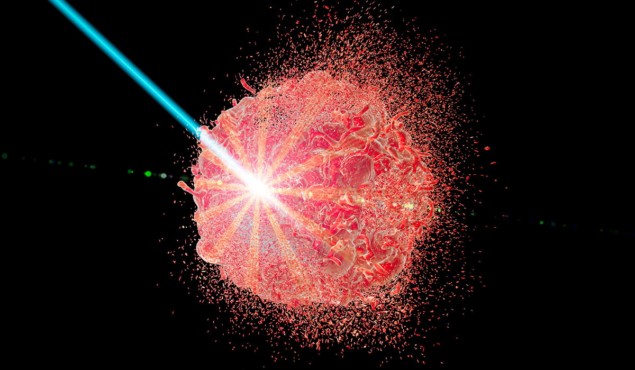
FLASH radiotherapy – in which therapeutic radiation is delivered at ultrahigh dose rates – shows promise as a new treatment for hard-to-kill tumours. Preclinical studies in animals suggest that the FLASH technique causes less damage to normal tissue than standard radiotherapy, while still effectively killing cancer cells. This offers the possibility of delivering larger radiation doses without increasing side effects, thereby achieving higher cure rates for patients with resistant tumours.
Now researchers at the University of Cincinnati Cancer Center have performed a first-in-human trial evaluating the use of FLASH proton therapy for treating patients with painful bone metastases. Results of the FAST-01 trial, reported at this week’s ASTRO Annual Meeting and in JAMA Oncology, revealed the feasibility of the clinical workflow for FLASH proton therapy and demonstrated that the treatment was as effective as conventional radiotherapy for pain relief, without causing unexpected side effects.
Most early FLASH radiotherapy studies – including the only previous in-human treatment, of a single patient with widespread cutaneous T-cell lymphoma – employed electrons. But electron beams only penetrate a few centimetres into tissue, limiting their applicability for clinical treatments. In this prospective clinical study, the team used proton beams to deliver the ultrahigh dose-rate radiation, which penetrate deep enough to reach tumour locations in most people.
The trial included 10 patients with painful bone metastases in their arms and legs (a total of 12 metastatic sites) who would otherwise been treated with conventional radiotherapy. Patients received a single 8 Gy fraction, as used in the standard-of-care X-ray treatment, but delivered at 40 Gy/s or greater – 1000 times the dose rate of conventional-dose-rate photon radiotherapy. Treatments were performed using a FLASH-enabled ProBeam proton therapy system at the Cincinnati Children’s/UC Health Proton Therapy Center.
“We used this patient population because, as a safety trial, we wanted to start with patients with low risk of serious toxicity,” explained Emily Daugherty, who described the findings at the ASTRO conference. “If we’re irradiating the arm there’s a low risk to critical organs – we’re only treating bone, muscle and nerves, we’re not irradiating the spinal cord or heart. Also, this group of patients is one that stands to benefit from a shorter treatment time on the table.”
Daugherty and colleagues evaluated both the workflow feasibility and toxicity of the FLASH proton therapy. The average time on the treatment table was 15.8 min per treated site – although the FLASH delivery itself takes less than a second – and no FLASH-related technical issues or delays occurred. Side effects from the treatment were mild, with the most common being transient mild skin hyperpigmentation. “Very importantly, there were no serious adverse events related to FLASH in humans,” Daugherty noted.
The researchers also monitored the patient’s pain levels, use of pain medication and adverse events, on the day of treatment, and at various time points after. Following FLASH radiotherapy, seven of the patients experienced complete or partial pain relief. Of the 12 treated sites, pain was relieved completely for six sites and partially for two additional sites. They note that this is similar to the outcomes of 8 Gy conventional-dose-rate radiotherapy administered for painful bone metastases.

FLASH radiotherapy: from preclinical promise to the first human treatment
With both the treatment efficacy and toxicity comparable with that of conventional palliative radiotherapy, the researchers suggest that their findings support the further exploration of FLASH for other clinical indications. They are now enrolling patients into a second trial, FAST-02, which will assess the use of FLASH proton therapy in subjects with thoracic bone metastases.
“By treating thoracic bone metastases, we’ll be able to look at toxicity to organs such as the lungs and the heart,” Daugherty explained. “FLASH is a very promising and potentially practice-changing treatment modality. Incrementally we’re going to be advancing FLASH in humans, and FAST-01 truly demonstrates the very first and exciting step.”



